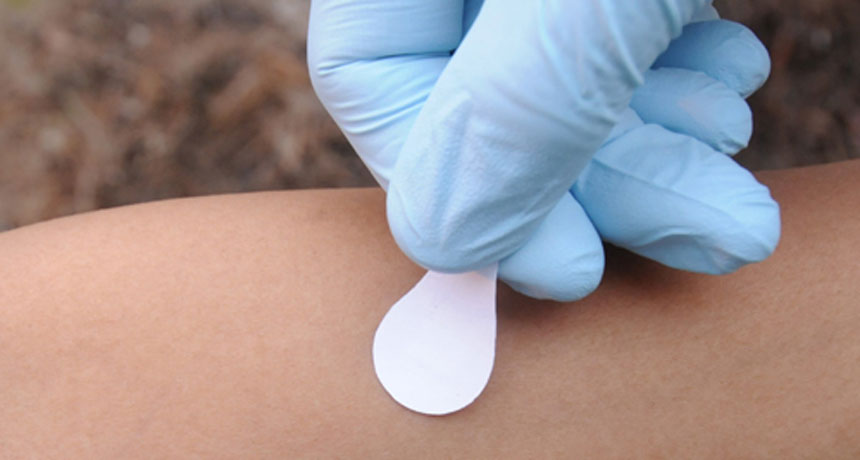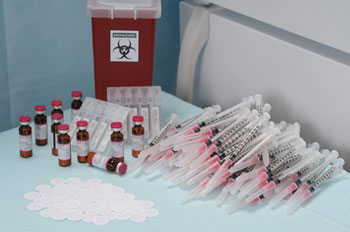Ouchless measles vaccine could save lives
Patches could get life-saving vaccine to the people who need it most

Giving someone a measles vaccine through a small patch could be easier for nurses and painless for patients.
Gary Meek/Georgia Tech
WASHINGTON, D.C. — Measles is a killer. This viral disease claimed more than 300 lives every day, on average, in 2014 alone. That’s according to the World Health Organization in Geneva, Switzerland. Yet a life-saving vaccine has been available since 1963. Two doses can keep almost everyone who gets them from catching the measles. Outbreaks can largely be prevented if most people who are able to get the vaccine in fact do receive it. And a new drug-dispensing patch could help that happen.
It could make it easier to bring the vaccine to the children who need it — especially those in rural areas of developing countries.
Normally, the vaccine must stay cold until it’s used. It comes in multi-dose bottles that someone might not open for just one or two children. A trained person must mix the vaccine with another liquid and then inject the mix with a needle. Used needles then need special disposal.
All of these factors can limit access to the measles vaccine, says James Goodson. As an epidemiologist at the Centers for Disease Control and Prevention (CDC) in Atlanta, Ga., he studies how diseases spread. Goodson and others spoke here, February 14, at the annual meeting of the American Association for the Advancement of Science (AAAS). They discussed progress and challenges in fighting measles worldwide.
They also showcased the new patch being developed to painlessly dispense this and other vaccines.
Teeny, tiny needles
Researchers at the Georgia Institute of Technology (Georgia Tech) in Atlanta are now working with Goodson and others at the CDC on a new way to deliver the measles vaccine. “It’s a skin patch,” says Goodson. “You put it on like a Band-Aid.”
Skin patches already deliver some drugs. One example is the nicotine patch that can help a person quit smoking. But the measles vaccine doesn’t get absorbed if it sits on top of the skin. It has to get through the skin’s outer barrier to work.
“The barrier is very thin,” notes Mark Prausnitz. He’s a chemical engineer at Georgia Tech. The top skin barrier is only about ten micrometers thick. That’s about a tenth as thick as a human hair, he explains. “So a hypodermic needle is really overkill. You could use an extremely short needle.”
That was a “key realization,” he says. Electronics engineers already knew how to make very tiny devices, so his Georgia Tech team built on those approaches. “We took their ways of making little things, and we adapted them to make little needles.”
Each patch holds 100 tiny needles, each just over half a millimeter (about 0.02 inch) long. Under a strong magnifying glass, the surface of the patch looks like a grid of tiny dots. Each dot is a microneedle made of a dry vaccine, sugar, a polymer and a few other ingredients.
A polymer’s molecules are long chains of repeating groups of atoms. It provides strength so the microneedle does not bend or break before piercing the skin, explains Prausnitz. The other ingredients help keep the vaccine stable.
Once someone presses the patch on, its microneedles enter the skin and dissolve in the skin’s fluids. That releases the vaccine so it can be taken up by cells of the immune system. The polymer eventually leaves a person’s body in the urine.
In a trial with rhesus macaque (REE-sus Ma-KAK) monkeys, those who got the patch had the same level of protection against measles as did a control group that got the current vaccine. Just as importantly, the treated animals didn’t have any dangerous reactions. The Georgia Tech and CDC researchers reported these results last fall in Vaccine.
What’s next
“We’re really excited about this,” says Goodson. Each patch is a single dose, and it can remain stable for months at room temperature. No special skill is needed to apply the vaccine, and the patch only needs to stay on for a few minutes. Plus, no dangerous waste is left at the end. “We could take the vaccine door to door” even in remote areas, he says.

The measles vaccine patch will be ready for trials in people as soon as money is available, he adds. A similar vaccine patch for the flu is already undergoing such trials. Also in the works: a polio-vaccine patch.
“The shift to these kinds of technologies could really be a game changer in vaccination,” says Matthew Ferrari, who did not work on the measles patch. He’s an epidemiologist at Pennsylvania State University in State College. As he sees it, a patch could get rid of the need for an expensive system for storing and transporting vaccines that must be kept cold. Patches also would make it much easier to treat people in remote areas.
And the more people who get the vaccine, the better it is for everyone. “Every time you protect a child, not only do you protect that child, but you protect anyone that child might [otherwise] infect,” explains Ferrari. Medical reasons prevent some people from getting a vaccine. And some babies are too young to get one yet. To protect those people, he says, “we need 100 percent of those who are eligible to get the vaccine.”
Power Words
(for more about Power Words, click here)
atom The basic unit of a chemical element. Atoms are made up of a dense nucleus that contains positively charged protons and neutrally charged neutrons. The nucleus is orbited by a cloud of negatively charged electrons.
average (in science) A term for the arithmetic mean, which is the sum of a group of numbers that is then divided by the size of the group.
Centers for Disease Control and Prevention, or CDC An agency of the U.S. Department of Health and Human Services, CDC is charged with protecting public health and safety by working to control and prevent disease, injury and disabilities. It does this by investigating disease outbreaks, tracking exposures by Americans to infections and toxic chemicals, and regularly surveying diet and other habits among a representative cross-section of all Americans.
chemical engineer A researcher who uses chemistry to solve problems related to the production of food, fuel, medicines and many other products.
clinical trial A research trial that involves people.
control A part of an experiment where there is no change from normal conditions. The control is essential to scientific experiments. It shows that any new effect is likely due only to the part of the test that a researcher has altered. For example, if scientists were testing different types of fertilizer in a garden, they would want one section of it to remain unfertilized, as the control. Its area would show how plants in this garden grow under normal conditions. And that gives scientists something against which they can compare their experimental data.
developing country A poorer country with relatively little industry and a lower standard of living than industrial countries, such as the United States and Canada.
electronics Devices that are powered by electricity but whose properties are controlled by the semiconductors or other circuitry that channel or gate the movement of electric charges.
engineer A person who uses science to solve problems. As a verb, to engineer means to design a device, material or process that will solve some problem or unmet need.
epidemiologist Like health detectives, these researchers figure out what causes a particular illness and how to limit its spread.
hypodermic needle A hollow needle used to deliver fluids, such as medicines, beneath the skin or to extract fluids, such as blood, from the body.
immune system The collection of cells and their responses that help the body fight off infections and deal with foreign substances that may provoke allergies.
influenza (or flu) A highly contagious viral infection of the respiratory passages causing fever and severe aching. It often occurs as an epidemic.
measles A highly contagious disease, typically striking children. Symptoms include a characteristic rash across the body, headaches, runny nose, and coughing. Some people also develop pinkeye, a swelling of the brain (which can cause brain damage) and pneumonia. Both of the latter two complications can lead to death. Fortunately, since the middle 1960s there has been a vaccine to dramatically cut the risk of infection.
micrometer (sometimes called a micron) One thousandth of a millimeter, or one millionth of a meter. It’s also equivalent to a few one-hundred-thousandths of an inch.
molecule An electrically neutral group of atoms that represents the smallest possible amount of a chemical compound. Molecules can be made of single types of atoms or of different types. For example, the oxygen in the air is made of two oxygen atoms (O2), but water is made of two hydrogen atoms and one oxygen atom (H2O).
nicotine A colorless, oily chemical produced in tobacco and certain other plants. It creates the ‘buzz’ effect associated with smoking. It also is highly addictive, making it hard for smokers to give us their use of cigarettes. The chemical is also a poison, sometimes used as a pesticide to kill insects and even some invasive snakes or frogs.
outbreak The sudden emergence of disease in a population of people or animals. The term may also be applied to the sudden emergence of devastating natural phenomena, such as earthquakes or tornadoes.
polio An infectious viral disease that affects the central nervous system and can cause temporary or permanent paralysis.
polymer A substance whose molecules are made of long chains of repeating groups of atoms. Manufactured polymers include nylon, polyvinyl chloride (better known as PVC) and many types of plastics. Natural polymers include rubber, silk and cellulose (found in plants and used to make paper, for example).
rhesus monkey (also called rhesus macaque) A small brown macaque with red skin on the its face and rump, native to southern Asia. It is often kept in captivity and is widely used in medical research.
vaccine A biological mixture that resembles a disease-causing agent. It is given to help the body create immunity to a particular disease. The injections used to administer most vaccines are known as vaccinations.
virus Tiny infectious particles consisting of RNA or DNA surrounded by protein. Viruses can reproduce only by injecting their genetic material into the cells of living creatures. Although scientists frequently refer to viruses as live or dead, in fact no virus is truly alive. It doesn’t eat like animals do, or make its own food the way plants do. It must hijack the cellular machinery of a living cell in order to survive.
World Health Organization An agency of the United Nations, established in 1948, to promote health and to control communicable diseases. It is based in Geneva, Switzerland. The United Nations relies on the WHO for providing international leadership on global health matters. This organization also helps shape the research agenda for health issues and sets standards for pollutants and other things that could pose a risk to health. WHO also regularly reviews data to set policies for maintaining health and a healthy environment.
This is one in a series presenting news on invention and innovation, made possible with generous support from the Lemelson Foundation.







